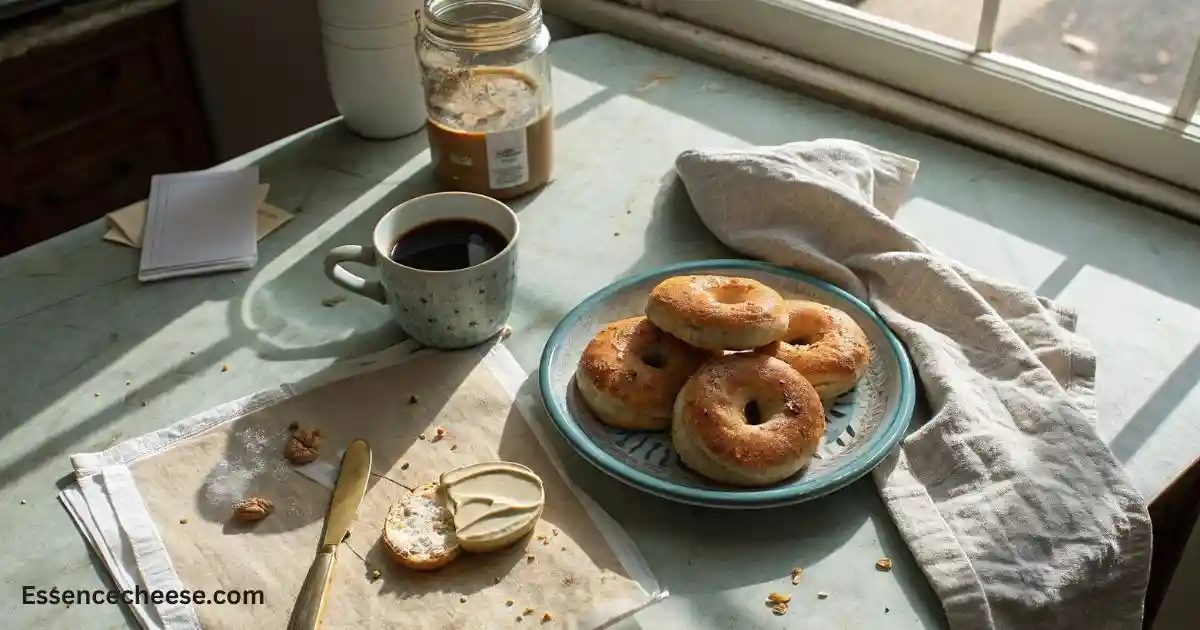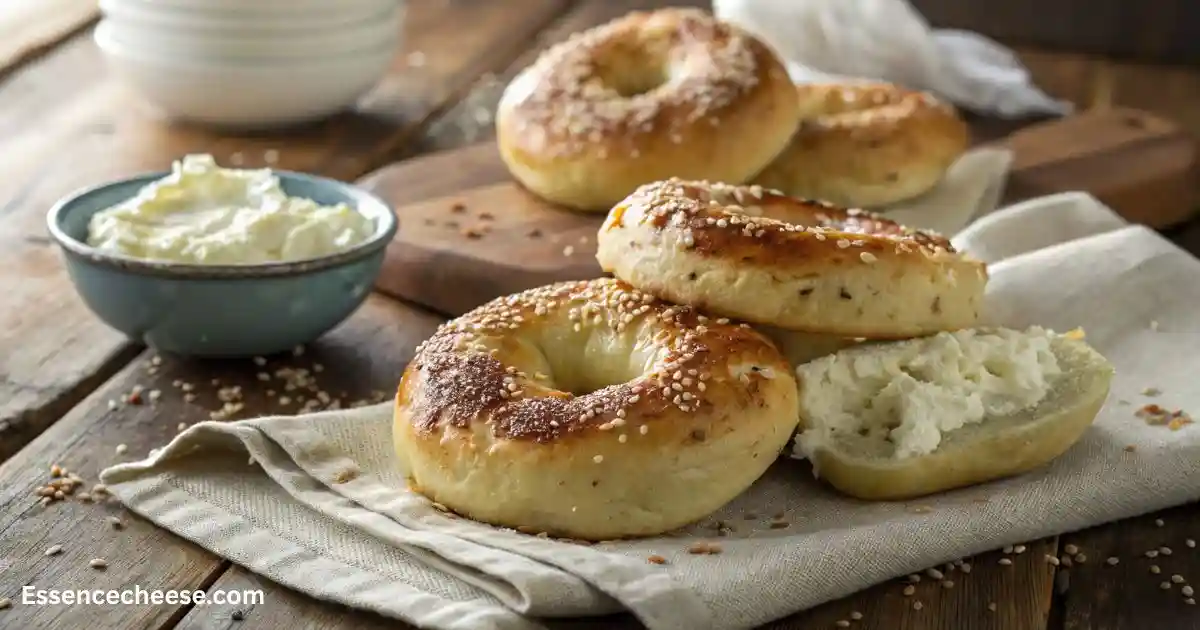Cottage Cheese Bagels Easy High Protein Recipe
Let’s be honest, most bagels feel like a carb bomb. You bite in, it’s chewy and satisfying, sure, but thirty minutes later? You’re hungrier than when you started. That’s why cottage cheese bagels have quietly become the breakfast hack of the year.
This isn’t just another food trend. This is the healthy bagel recipe that bridges your love for carbs with your body’s need for protein. Using simple ingredients, no yeast, no kneading, no gluten if you don’t want it, this cottage cheese bagel recipe gives you a soft, golden crust with a chewy interior and 10–14g of protein per serving.
Whether you’re on a low-carb diet, tracking macros, or just looking to eat smarter without ditching your cravings, these low-carb, protein bagels punch above their weight. Oh, and yes, there’s a gluten-free cottage cheese bagels version too.
In this post, I’ll walk you through:
- The why behind the hype
- How to make them (oven and air fryer)
- Key ingredient swaps for low-carb or gluten-free versions
- Topping ideas, storage tips, and a no-B.S. nutrition breakdown
Ready? Let’s roll up our sleeves.
Table of Contents
Why Cottage Cheese Bagels Are Worth Making (Even If You’re Not on a Diet)
Let’s just put this out there. Most “healthy bagels” either taste like bland hockey pucks or fall apart the second you take a bite. But these? They hit differently. They’re soft, chewy, golden on top, and secretly packed with protein. And they don’t pretend to be something else. They are bagels. They just happen to work better with your body.
Here’s why so many people are ditching store-bought and baking their own.
More Protein, Less Crash
You know how regular bagels leave you hungry an hour later? That’s the carb trap. These cottage cheese bagels flip the script. They give you about 10 to 14 grams of protein per serving, which helps you stay full longer and keeps your energy more stable. That means no more mid-morning snack attacks or post-bagel slumps.
If you’ve ever tried tracking macros or just wanted to feel more fueled after breakfast, you’ll notice the difference almost immediately.
No Rising. No Waiting. No Fuss.
Traditional bagels need time. Time to rise, time to boil, time to bake. This recipe skips the yeast and goes straight to the oven. From mixing to baking, you’re done in under half an hour. That makes them perfect for busy mornings or random Sunday cravings.
No stand mixer. No waiting around. Just mix, shape, bake, and boom.
Gluten-Free? Easy.
If you need or prefer gluten-free, this recipe works beautifully with a 1-to-1 flour blend or oat flour. No weird textures or chalky flavor. They still come out chewy on the inside and golden on the outside. You can also go lower-carb by experimenting with almond flour or flax blends.
The beauty is that the cottage cheese brings moisture and structure, so the swaps don’t ruin the vibe.
Not Just for Dieters
Even if you don’t care about carbs or calories, these still win on flavor and ease. But if you are trying to eat more protein, keep blood sugar in check, or just find smarter swaps for everyday foods, this one makes the list. It feels like comfort food but behaves more like fuel.
Are These Bagels Actually Healthy?
They really are. They’ve got more protein and fewer carbs than regular bagels. You don’t need yeast or special tools, and the ingredients are easy to customize. Whether you’re gluten-free, trying to eat more protein, or just want something better for breakfast, they check every box.
Ingredient Breakdown
Let’s be honest for a second. Most recipes say “simple ingredients” and then hit you with something like tapioca starch or powdered monk fruit. This one actually means it. You probably have everything already, or at least close. And if you don’t? I’ve got swaps that don’t wreck the texture or taste.
Here’s the basic list:
- Cottage cheese (a cup, full-fat if you can)
- Self-rising flour (also a cup)
- One egg
- Baking powder (only if your flour isn’t self-rising)
- A pinch of salt (if your cottage cheese is on the bland side)
That’s it. Mix, shape, bake. But if you’re like me and always ask, “Can I swap this?” — you’re in luck.
Let’s Talk Cottage Cheese
The full-fat stuff is your friend here. It’s creamy, rich, and keeps things soft. Low-fat will work, but you might notice a little less flavor. Also, if you’re not a fan of chunky curds, just give it a quick blend. Smooth cottage cheese makes a smoother dough, but it’s not required.
Flour Options That Actually Work
If you’ve got self-rising flour, you’re already ahead. If not, just use regular all-purpose and stir in about one and a half teaspoons of baking powder and a little salt.
Gluten-free? Totally doable. Grab a 1-to-1 gluten-free flour blend that’s meant for baking (not almond flour on its own — trust me, that turns into paste). King Arthur’s or Bob’s Red Mill both work well.
Curious about oat flour? It adds a little sweetness and makes the bagels denser in a good way. You might want to toss in a bit of arrowroot or cornstarch to help them rise if you go that route.
For the Low-Carb Crowd
Want to keep things light on carbs or boost the fiber? I’ve played with a few combos that hold up:
- Half almond flour, half oat flour
- A tablespoon of psyllium husk for stretchiness
- A spoonful of hemp or chia seeds for bonus crunch
These bagels aren’t keto, but they lean much closer to the low-carb side than anything you’d grab at the store.
Do I Have to Use an Egg?
Nope. It helps bind the dough and gives that shiny top if you brush it on before baking. But if you’re egg-free, a little olive oil or plant milk on top works in a pinch. Just don’t skip the moisture — otherwise, the tops bake up pale and dry.
Step‑by‑step Recipe
Okay, no recipe voice here. Just me, walking you through it the way I’d tell a friend. No weird techniques. No flour explosions. Just dough, hands, heat, and something chewy at the end.
First: Oven On
If I don’t turn the oven on right away, I forget. So go ahead and do it now — 375 degrees. Grab a baking tray. I use parchment because I hate scrubbing baked-on bits later, but do what you want.
I also crack an egg and whisk it in a cup. That’s for brushing the tops later. If I skip it, they still taste fine but look kinda sleepy.
Mixing the Dough
Dump the cottage cheese in a bowl. Add the flour. If it’s not self-rising, add baking powder and a bit of salt. Stir it all together. Honestly, don’t stress about mixing perfectly. Mine usually looks like something between pizza dough and lumpy mashed potatoes for the first minute or two.
If your dough is super sticky — like clinging to your fingers — pause and let it sit for five. Or dust in a bit of flour. Not too much or you’ll end up with biscuit rocks.
Shaping Without Losing Your Cool
This part’s messy if you rush. I flour my hands lightly. Then I just divide the dough into four sort-of-equal balls. I roll them into ropes with my palms, like playdough. About as long as your hand. Pinch the ends together to make a circle. If they look wonky, it’s fine. They’ll bake up cute.
Put those on your baking sheet, spaced out a bit. Sprinkle whatever you’re into on top. Sometimes I do sesame. Sometimes I forget and pretend I meant to keep them plain.
Into the Oven They Go
Brush the tops with the egg if you made it. Then bake for maybe 20 to 25 minutes. Depends on your oven. I usually peek around minute 18. Once they’re golden on top and smell like something you wanna eat immediately, pull them out.
I let them sit for maybe 10 minutes. They finish setting as they cool, and slicing is less messy if you wait. But yeah — sometimes I don’t.
What If I Want to Air Fry Them?
Totally doable. I do 325 degrees, and about 10 to 12 minutes. I line the basket with parchment because I’ve learned the hard way. Flip them once if your air fryer cooks unevenly. Keep an eye out. They brown fast.
Variations & Toppings
Okay, once you’ve made these a couple of times, you’ll probably want to change things up. And honestly, that’s half the fun. These bagels are a solid blank canvas, so you can go classic, savory, sweet, spicy, or something weird you saw on TikTok at 2 a.m.
Here’s what I’ve tried and actually liked:
Classic Toppings
- Everything bagel seasoning, obviously
- Sesame seeds
- Poppy seeds
- Sea salt flakes (crunchy ones, not table salt)
- Dried onion or garlic flakes
Brush the tops with egg first so all this stuff sticks. If you forget, just press it in gently before baking.
Sweet Stuff
If you’re in a mood or making these for brunch, skip the garlic and go this direction instead:
- Cinnamon and coconut sugar
- Chopped raisins or dried cranberries inside the dough
- A swirl of maple syrup or honey on top after baking
- Blueberries folded into the mix (a little tricky but doable if you chill the dough)
They taste good with cream cheese, nut butter, or even a little yogurt and fruit on top.
Savory Upgrades
Want to level them up into something you could eat for lunch? Try this:
- Fold in a handful of shredded cheddar
- Add cracked black pepper and chopped chives
- Mix in a spoon of pesto
- A few bits of cooked bacon or sun-dried tomato can be wild if you’re feeling bold
Don’t overdo it or the dough gets hard to shape. But small amounts make a big difference.
Air Fryer Tweak
If you’re using an air fryer, go light on toppings. Stuff flies around in there. You can press them in deeper or brush with a little oil so they stick better.

Nutrition and Health Comparison
How These Stack Up to Store-Bought Bagels
Let’s start with the obvious. A regular bagel from the store is usually pretty big. Most clock in around 250 to 300 calories before you add anything on top. They tend to have very little protein, almost no fiber, and a whole lot of refined carbs. Tasty, sure. Filling, not really.
Calories
One homemade cottage cheese bagel comes in around 160 to 190 calories depending on the flour you use and whether you add toppings. That’s with the basic version, nothing fancy.
If you go gluten free or swap in almond flour, the number drops a little. Add shredded cheese or seeds and it goes up, but not by much.
Protein
Here’s where these really shine. Most store-bought bagels give you 7 to 9 grams of protein at best. These homemade ones usually hit 10 to 14 grams. That depends on your cottage cheese and whether you use an egg wash, but the bump is real.
Protein helps keep you full longer. It also slows the rise in blood sugar after you eat. So you don’t get that crashy feeling an hour later.
Carbs
Traditional bagels? Around 45 to 55 grams of carbs. These cottage cheese bagels land closer to 20 to 30 grams depending on flour. If you use oat flour or a mix with almond or flax, that number can drop even further.
So if you’re watching carbs or aiming for better blood sugar balance, this version is way easier on your body.
Fiber and Fat
The base recipe has a little fiber from the flour, but not a lot. If you want more, try oat flour, flax meal, or sprinkle chia seeds into the dough. They don’t mess with the texture and add bonus nutrients.
Fat content depends on your cottage cheese. Full-fat makes them softer and richer. Low-fat works too but might feel a little drier the next day.
What It Means in Real Life
You eat one of these and feel good. That’s kind of the whole point. You don’t get that overly full, bloated feeling some people get with wheat-heavy bagels. You also don’t crash or reach for another snack twenty minutes later.
Final Thoughts
You know that feeling when something’s easy, and it actually turns out great, and you sort of blink at it like… why haven’t I been doing this all along?
That’s what these bagels are.
They take basic ingredients you probably already have, and somehow they come out warm, chewy, satisfying, and kind of impossible to mess up once you get the hang of it. They work whether you’re counting carbs, eating more protein, going gluten free, or just trying to eat real food that doesn’t make you feel sluggish an hour later.
And even if none of that matters to you? They still taste good.
So give them a shot. Try the basic version first. Then tweak it. Swap the flour, add some toppings, throw in a little cinnamon or cheese, whatever you’re into. The recipe can take it.
If you make a batch and love them, let me know. Drop a comment, send a pic, tag me if you post it. I always want to see what other people come up with.
And if you want more recipes like this, I’ve got a few. Easy, high protein, secretly better-for-you stuff that doesn’t feel like a compromise. Just say the word.
Now go preheat your oven.

Cottage Cheese Bagels
Ingredients
Base
- 1 cup cottage cheese (full‑fat) or low‑fat/blended smooth
- 1 cup self‑rising flour or AP flour + 1½ tsp baking powder + pinch salt
- 1 large egg plus extra for egg wash
Optional Add‑ins & Toppings
- 1 tbsp baking powder only if using AP flour
- pinch salt
- toppings (sesame, poppy, everything seasoning, seeds) optional, for sprinkling
Instructions
- Preheat oven to 375 °F (190 °C). Line a baking tray with parchment.
- Whisk one egg in a small cup for brushing later.
- In a bowl, mix cottage cheese, flour, egg, and if using AP flour, add baking powder and salt. Stir until dough forms (lumpy is ok). Add a little flour if too sticky; or rest 5 minutes.
- Divide dough into 4 equal portions. Lightly flour hands, roll each into a rope, and join ends to form bagel shapes. Place on tray spaced apart.
- Brush tops with egg wash, then sprinkle toppings if using.
- Bake 20–25 minutes, until golden and fragrant. Check around 18 minutes. Let cool 10 minutes before slicing.
- Air-Fryer Option: Preheat to 325 °F (165 °C). Bake 10–12 minutes, flip halfway, watching for browning.
Notes
F.A.Qs
Is cottage cheese actually good for bagels?
Weirdly, yes. If you’d told me a few years ago I’d be mixing cottage cheese into bagel dough, I’d have laughed. But it works. It keeps the texture soft, adds just enough moisture, and gives the bagels a protein boost that you can actually feel. They don’t taste like cottage cheese either, more like a bagel that secretly has its life together.
How do you make Bethenny Frankel’s viral cottage cheese bagel?
It’s simple. Blend cottage cheese until smooth, then stir in an egg, some baking powder, and flour. That’s it. Shape into a circle, bake, and you’re done. Her version uses half a cup of cottage cheese, one egg, and about half a cup of self-rising flour. Bake around 375 for 20 minutes. You can brush the top with egg and sprinkle with seasoning if you want that shiny, golden finish.
What’s actually good on a cottage cheese bagel?
Honestly, whatever you’re craving. For breakfast, I like almond butter with a few banana slices. If I’m feeling savory, avocado with chili flakes or a little smoked salmon and cream cheese hits the spot. Sometimes I’ll just toast it and spread on salted butter and flaky salt. Don’t overthink it. These bagels are pretty friendly with most toppings.
Why do bodybuilders eat cottage cheese before bed?
Because it’s packed with casein protein, which takes its time to digest. That slow release helps muscles recover overnight. Plus, it’s low in sugar and pretty filling, so it won’t mess with your sleep or spike blood sugar. You don’t have to be a bodybuilder to benefit from it. It’s just a smart pre-bed snack if you’re lifting or training.
Which has more protein: Greek yogurt or cottage cheese?
Cottage cheese, by a bit. A cup of it gives you somewhere around 24 to 28 grams of protein, depending on the brand. Greek yogurt is still solid, usually around 18 to 20 grams. Both are great, but if you’re counting grams or trying to stay full longer, cottage cheese pulls ahead. Bonus — it usually has less sugar too.
Have you given our recipe a try ?
There are no reviews yet. Be the first one to write one.
Last Updated on August 4, 2025 by Janelle
- Perfect Cheesecake Cookies (Soft, Tangy & Rolled in Graham Crust) - December 27, 2025
- The Ultimate Turkey Cheese Sandwich: Hot Melt and Cold Deli Recipes - December 13, 2025
- Cream Cheese Pasta Sauce (Better Than Alfredo in 15 Minutes) - November 29, 2025

